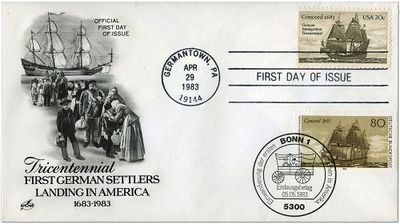Concord (Ship)

Source: National Postal Museum
Concord was the name of the ship that carried the first German immigrant group from Europe to America, composed of 13 Mennonite-Quaker families of Krefeld.
In 1681, William Penn, an English real estate entrepreneur, received a large grant of land from King Charles II. This grant included present-day Pennsylvania and Delaware. Penn, a Quaker, chose to draft a charter of liberties for his colony guaranteeing free and fair trial by jury, freedom of religion, freedom from unjust imprisonment, and free elections. The colony was to be a refuge for Quakers who were facing persecution. James Claypoole, a London businessman and Quaker who knew William Penn, purchased 5,000 acres of land in the new settlement and chose to move his family and business to America. For the move, Claypoole contracted with William Jefferies, master of the English schooner called the Concord, a 500 ton ship measuring 130 by 32 feet. The ship left Rotterdam on 6 July 1683 and arrived in Gravesend. Here twelve fellow Quakers (many who were former Mennonites) and one Mennonite with their families from Krefeld, 33 persons in all, made their way to Gravesend to join the Claypoole family on the voyage.
The Concord left London, England on 24 July 1683 and arrived in the port of Philadelphia on 6 October after a voyage of 75 days. Here the German immigrants were greeted by a German lawyer, Franz "Francis" Daniel Pastorius, a close friend of Willian Penn. He had arrived in Philadelphia earlier in August to help prepare for the arrival of the Concord. Pastorius assisted the newcomers in establishing the Germantown Mennonite Settlement.
Although the Concord carried a complement of 40 crewmen and 120 passengers, these are the family heads recognized as constituting what has become known as "The Thirteen" (in alphabetical order):
| No. | Head of Household | Further Details |
|---|---|---|
| 1. | Leonard Arets | variant spellings of the surname: Aratts, Arents, Van Aaken. |
| 2. | Abraham Isacks Op den Graeff | wife Trintgen (Jansen); later re-joined the Mennonites. |
| 3. | Derick Isacks Op den Graeff | wife Nolcken (Vyten). |
| 4. | Hermann Isacks Op den Graeff | wife Liesbet Isacks (Van Bebber), sister Margrit Isaaks Op den Graef, and mother Grietgen (Peters) (died 19 October 1683). |
| 5. | Wilhelm Strepers | wife Belcken (Tuffers) and children: Peter, 19; Dirck, 17; Leonard, 15; Lysken, 13; and Jennecken, 9. His brother Johann Strepers (wife Anna Doors) bought land from William Penn and sent Wilhelm to |
| 6. | Tönes Coenen-Heggers | wife Lentgen (Matteis-Doors), about 33 and children: Conrad, Matthias, Agnes, and Entgen. Variant spellings of the surname: Kunders, Conradts, and Hekkers. |
| 7. | Reiner Theissen-Doors | variant spelling of surname: Tyson; brother to Tönes Kunders' and Peter Kürlis' wife's who also came over in 1683. Also known as Leonard Rynier Teison. Reiner Theisen had been raised Mennonite but |
| 8. | Johann "Jan" Simons | wife Merken (Wilhelms-Lucken) and child Merken, about 30; his wife was sister to Johann Lucken. |
| 9. | Johann "Jan" Lenssen | wife Mercken (Pieters-Schmitz). The only family that were not Quakers; they were Mennonites. |
| 10. | Peter Kürlis | wife Elisabeth (Doors) and children: Metje, 7; Johannes, 5; Agenes, 2; and Metgen, 1/2 year. Originally a Reformed family. |
| 11. | Johannes Bleickers | wife and child: Peter, born at Sea. |
| 12. | Johann "Jan" Lucken | wife Merken (Gastes). |
| 13. | Abraham Tunes Klinken | wife Beatrix (Lucken); Wife was sister to Johann Lucken. |
Bibliography
Ganz, Cheryl R. "Germany - USA Joint Issue: Concord in 1683." Smithsonian National Postal Museum. October 2013. Web. 12 October 2013. http://www.postalmuseum.si.edu/museum/1d_Concord.html.
ProGenealogists. "1683 Concord." Web. 14 October 2013. http://www.progenealogists.com/palproject/pa/1683conc.htm.
Randall, Betty. "Germantown, Pennsylvania." German-American Teaching Resources and Units. 16 November 2007. Web. 14 October 2013. http://maxkade.iupui.edu/germantown.html.
Summers, Vincent. "William Penn and the "Original 13" Settlers of Germantown, Pennsylvania (1683): A Brief Discussion of Their History and the Author's Efforts to Establish a Core of Researchers." Yahoo. 17 March 2009. Web. 14 October 2013. http://voices.yahoo.com/william-penn-original-13-settlers-germantown-2895699.html?cat=37.
| Author(s) | Richard D Thiessen |
|---|---|
| Date Published | October 2013 |
Cite This Article
MLA style
Thiessen, Richard D. "Concord (Ship)." Global Anabaptist Mennonite Encyclopedia Online. October 2013. Web. 16 Apr 2024. https://gameo.org/index.php?title=Concord_(Ship)&oldid=102596.
APA style
Thiessen, Richard D. (October 2013). Concord (Ship). Global Anabaptist Mennonite Encyclopedia Online. Retrieved 16 April 2024, from https://gameo.org/index.php?title=Concord_(Ship)&oldid=102596.
©1996-2024 by the Global Anabaptist Mennonite Encyclopedia Online. All rights reserved.